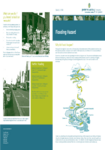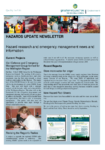-
Save the Drain for Rain
In urban areas, the pipes that collect rainwater from your
roof and yard are connected to a network of underground
pipes that transfer the rainwater to local streams or to the
seashore. These…alarm Published 19 Jun 2003 -
Save the Drain for Rain
Save the Drain for Rain is a pamphet that explains the
difference between the stormwater network and sewage
system. It describes common house hold wastes that
are often unintentionally disposed…alarm Published 02 Jun 2003 -
Inanga Spawning Habitats in the Wellington Region - Part 2 - Wairarapa
This report surveys the Inanga spawning habitats in the
Wairarapa, being the eastern districts of the Wellington Region,
and delivers the results of this study.alarm Published 02 Jun 2003 -
Flooding Hazards
An information sheet describing the flood hazards of the
Greater Wellington region.
Including: Why floods happen, what to do when building
or renovating, what is put at…alarm Published 01 Jun 2003 -
Corporate Environmental Policies
Greater Wellington - The Regional Council promotes
quality for life by ensuring our environment is protected
while meeting the economic, cultural and social needs of
the community. We achieve this…alarm Published 01 Jun 2003 -
Waiwhetu Stream Remedial Options Risk Assessment
The Hutt City Council and Greater Wellington Regional
Council have undertaken a programme to assess the
nature and extent of contaminated sediments in the
Waiwhetu Stream. Options for addressing the…There is no digital version of this document available, but you can get in touch with publications@gw.govt.nz to get a copy of the document.
alarm Published 01 Jun 2003 -
Flooding Hazard - Wairarapa
An information sheet describing the flood hazards of
Wairarapa. Including the places most at risk from a
big flood, the chances of a big flood occurring, a big…alarm Published 01 Jun 2003 -
Greater Wellington's Riparian Management Strategy
This document outlines the strategy's purpose of promoting
the management of riparian margins along the rivers and
streams in the Wellington Region. It assists owners of private
land to…alarm Published 01 Jun 2003 -
Hazards Update Newsletter May 2003
The May 2003 issue of Hazards, which looks at current
emergency management projects in the region as well
as recent reports and hazard updates.alarm Published 01 May 2003 -
Greater Wellington Parks - Draft Regional Parks Network Management Plan
This publication sets out the direction for managing the five
regional parks in the Wellington region; Battle Hill Farm
Forest Park, Belmont Regional Park, East Harbour
Regional Park, Queen…alarm Published 01 Apr 2003


